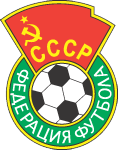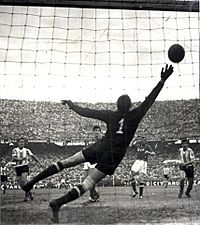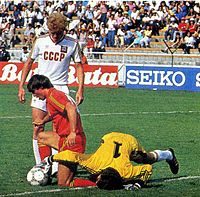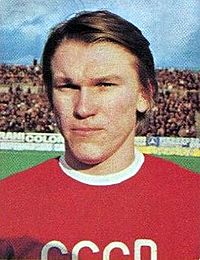Soviet Union national football team facts for kids
| to 1924–1991 | ||||||||||||||||||||||||||||||||||||||
|---|---|---|---|---|---|---|---|---|---|---|---|---|---|---|---|---|---|---|---|---|---|---|---|---|---|---|---|---|---|---|---|---|---|---|---|---|---|---|
 |
||||||||||||||||||||||||||||||||||||||
| Nickname(s) | Red Army | |||||||||||||||||||||||||||||||||||||
| Association | Football Federation of the Soviet Union | |||||||||||||||||||||||||||||||||||||
| Most caps | Oleg Blokhin (112) | |||||||||||||||||||||||||||||||||||||
| Top scorer | Oleg Blokhin (42) | |||||||||||||||||||||||||||||||||||||
| Home stadium | Central Lenin Stadium | |||||||||||||||||||||||||||||||||||||
| FIFA code | URS | |||||||||||||||||||||||||||||||||||||
|
||||||||||||||||||||||||||||||||||||||
| Elo ranking | ||||||||||||||||||||||||||||||||||||||
| Highest | 1 (1963–65, 1966, 1983–84, 1985–86, 1987, 1988) | |||||||||||||||||||||||||||||||||||||
| First international | ||||||||||||||||||||||||||||||||||||||
(Moscow, Soviet Union; 16 November 1924) |
||||||||||||||||||||||||||||||||||||||
| Biggest win | ||||||||||||||||||||||||||||||||||||||
(Moscow, Soviet Union; 16 September 1955) (Helsinki, Finland; 15 August 1957) |
||||||||||||||||||||||||||||||||||||||
| Biggest defeat | ||||||||||||||||||||||||||||||||||||||
(London, England; 22 October 1958) |
||||||||||||||||||||||||||||||||||||||
| World Cup | ||||||||||||||||||||||||||||||||||||||
| Appearances | 7 (first in 1958) | |||||||||||||||||||||||||||||||||||||
| Best result | Fourth place, 1966 | |||||||||||||||||||||||||||||||||||||
| European Championship | ||||||||||||||||||||||||||||||||||||||
| Appearances | 6 (first in 1960) | |||||||||||||||||||||||||||||||||||||
| Best result | Champions, 1960 | |||||||||||||||||||||||||||||||||||||
|
Medal record
|
||||||||||||||||||||||||||||||||||||||
The Soviet Union national football team was a top football team. It represented the Soviet Union from 1922 to 1991.
After the Soviet Union broke up, the team changed. It became the CIS national football team. Later, the Russia national football team took over its records. Many players from the Soviet team came from different parts of the Soviet Union. After it dissolved, some players joined the new Russian team.
The Soviet Union team played in seven World Cup tournaments. They only missed qualifying twice, in 1974 and 1978. Their best World Cup finish was fourth place in 1966. They lost to West Germany in the semifinals.
They also played in five European Championships. They won the first one in 1960. They beat Yugoslavia 2–1 in the final. They finished second three times (1964, 1972, 1988). In 1968, they finished fourth after losing a coin toss in the semi-final.
The Soviet team also won gold medals at the 1956 and 1988 Olympic Games. They were known for having strong players.
Contents
History of Soviet Football
Early Days and First Matches
After a big change in Russia in 1917, the country was cut off from many other nations. This made it hard for them to play international sports. In 1922, the Soviet Union was formed. They started to connect with other countries.
The first international match for a Soviet team was in September 1922. A team from Soviet Russia played against a Finnish team. The Soviet team won 4–1 in Petrograd. This was a big step for Soviet sports.
The first official match for the actual Soviet Union football team was a year later. They won 3–0 against Turkey. For many years, these were their only official international games.
Olympic Debut and Challenges
The Soviet Union first joined a big competition at the 1952 Summer Olympics. They beat Bulgaria 2–1. Then they played against Yugoslavia. This match was very important to both countries.
Yugoslavia was leading 5–1, but the Soviet team made an amazing comeback. The game ended in a 5–5 draw! They had to play again, and Yugoslavia won 3–1. This loss was tough for Soviet football.
World Cup Debut and European Glory
The Soviet Union joined the World Cup for the first time in 1958. They had a playoff game against Poland to qualify. They were in a tough group with Brazil, England, and Austria.
They made it to a playoff game against England and won. But then, Sweden, the host country, knocked them out in the quarter-finals.
The first European Championships in 1960 was a huge success. The Soviet team was supposed to play Spain. But Spain refused to travel to the Soviet Union because of political tensions. So, the Soviet team won by default.
In the semi-final, they beat Czechoslovakia 3–0. They reached the final against Yugoslavia. Yugoslavia scored first, but the Soviet Union, led by their famous goalkeeper Lev Yashin, tied the game. In extra time, Viktor Ponedelnik scored the winning goal. This made the Soviets the first European Champions!
Later World Cups and European Championships
In the 1962 World Cup, the Soviet team tied 4–4 with Colombia. They won their group but were again knocked out by the host country, Chile, in the quarter-finals. Their star goalkeeper, Lev Yashin, had a tough tournament.
In 1964, the Soviet Union tried to win the European Championship again. They reached the final in Spain. But Spain, the host, scored a late goal and won 2–1.
The 1966 FIFA World Cup was their best World Cup performance. They won all their group matches against North Korea, Italy, and Chile. They then beat Hungary in the quarter-finals. But they lost to West Germany in the semi-finals. They finished fourth after losing to Portugal in the third-place match.
For the Euro 1968, the semi-final against Italy ended 0–0. The winner was decided by a coin toss! Italy won the toss and went to the final. The Soviets lost the third-place match to England.
The 1970s and Beyond
The 1970 World Cup saw the Soviet team make history. They were the first team to make a substitution in a World Cup match. They reached the quarter-finals but lost to Uruguay in extra time. This was the last time they reached the quarter-finals in a World Cup.
In the 1972 European Championships, the Soviets reached the final. They lost to a strong West German team. This was one of two times they finished as runners-up in the Euros.
The rest of the 1970s were not as successful. They did not qualify for the 1974 or 1978 World Cups. They also missed the 1976 and 1980 European Championships.
The Soviet Union returned to major tournaments at the 1982 World Cup. They were in a group with Brazil, Scotland, and New Zealand. They were eliminated in the second group stage.
They qualified for the 1986 World Cup. They had a great group stage, scoring nine goals. But they lost to Belgium 3–4 in extra time in the Round of 16. This team scored the most goals for the Soviet Union in a World Cup, with 12 goals.
The Final Years
The Soviet Union qualified for the 1988 European Championship. They finished first in their group. They beat Italy 2–0 in the semi-final. In the final, they played the Netherlands again. This time, the Netherlands won 2–0 and became champions.
The last major tournament for the Soviet team was the 1990 FIFA World Cup. They were in a group with Argentina, Romania, and Cameroon. Their only win was 4–0 against Cameroon. They lost their other matches and did not get out of the group. This was the only time they failed to pass the group stage in a World Cup.
The Soviet Union qualified for Euro 1992. But the Soviet Union broke up before the tournament. So, the CIS national football team took their place. After that tournament, the former Soviet republics started playing as separate countries. Russia inherited the Soviet team's records.
Team Colors
The Soviet Union team usually wore red jerseys. They had white shorts and red socks.
Home Stadiums
The Soviet Union played their home games at many different stadiums. The main stadium was the Central Lenin Stadium in Moscow.
| Venue | City | Years Used | Played | Won | Drawn | Lost | Goals For | Goals Against | Points per game |
|---|---|---|---|---|---|---|---|---|---|
| Central Lenin Stadium | Moscow | 1956–1992 | 78 | 50 | 18 | 10 | 151 | 50 | 2.15 |
| Central Stadium | Kiev | 1969–1990 | 12 | 10 | 1 | 1 | 27 | 6 | 2.58 |
| Lenin Dynamo Stadium | Tbilisi | 1967–1987 | 10 | 6 | 1 | 3 | 19 | 9 | 1.9 |
| Dynamo Stadium | Moscow | 1954–1971 | 9 | 7 | 2 | 0 | 41 | 8 | 2.56 |
| Lokomotiv Stadium | Simferopol | 1979–1989 | 4 | 4 | 0 | 0 | 11 | 1 | 3 |
| Kirov Stadium | Leningrad | 1967–1984 | 3 | 3 | 0 | 0 | 8 | 1 | 3 |
| Hrazdan Stadium | Yerevan | 1978 | 2 | 2 | 0 | 0 | 12 | 2 | 3 |
| Central Lokomotiv Stadium | Moscow | 1979–1988 | 2 | 2 | 0 | 0 | 5 | 1 | 3 |
| Central Stadium | Volgograd | 1977 | 1 | 1 | 0 | 0 | 4 | 1 | 3 |
| Pakhtakor Central Stadium | Tashkent | 1975 | 1 | 1 | 0 | 0 | 2 | 1 | 3 |
| Vorovsky Stadium | Moscow | 1924 | 1 | 1 | 0 | 0 | 3 | 0 | 0 |
| Black Sea Shipping Stadium | Odessa | 1974 | 1 | 0 | 0 | 1 | 0 | 1 | 0 |
| Totals | 1924–1992 | 123 | 86 | 22 | 15 | 281 | 80 | 2.28 | |
- These numbers include only official matches recognized by FIFA.
Top Players
The Soviet Union team had many talented players. Here are some of the players who played the most games and scored the most goals.
Most Games Played
| Rank | Player | Games Played | Goals | Years |
|---|---|---|---|---|
| 1 | Oleg Blokhin | 112 | 42 | 1972–1988 |
| 2 | Rinat Dasayev | 91 | 0 | 1979–1990 |
| 3 | Albert Shesternev | 90 | 0 | 1961–1971 |
| 4 | Anatoliy Demyanenko | 80 | 6 | 1981–1990 |
| 5 | Volodymyr Bezsonov | 79 | 4 | 1977–1990 |
| 6 | Lev Yashin | 78 | 0 | 1954–1967 |
| 7 | Sergei Aleinikov | 77 | 6 | 1984–1991 |
| 8 | Murtaz Khurtsilava | 69 | 6 | 1965–1973 |
| 9 | Oleg Protasov | 68 | 28 | 1984–1991 |
| 10 | Valeriy Voronin | 66 | 5 | 1960–1968 |
Top Goalscorers
| Rank | Player | Goals | Games Played | Ratio | Years |
|---|---|---|---|---|---|
| 1 | Oleg Blokhin | 42 | 112 | 0.38 | 1972–1988 |
| 2 | Oleg Protasov | 29 | 68 | 0.43 | 1984–1991 |
| 3 | Valentin Ivanov | 26 | 59 | 0.44 | 1956–1965 |
| 4 | Eduard Streltsov | 25 | 38 | 0.66 | 1955–1968 |
| 5 | Viktor Kolotov | 22 | 55 | 0.4 | 1970–1978 |
| 6 | Viktor Ponedelnik | 20 | 29 | 0.69 | 1960–1966 |
| Igor Chislenko | 20 | 53 | 0.38 | 1959–1968 | |
| 8 | Anatoliy Banishevskiy | 19 | 50 | 0.38 | 1965–1972 |
| 9 | Anatoliy Ilyin | 16 | 31 | 0.52 | 1952–1959 |
| 10 | Anatoliy Byshovets | 15 | 39 | 0.38 | 1966–1972 |
Tournament Records
The Soviet Union football team competed in several major international tournaments.
FIFA World Cup Record
Champions Runners-up Third place Fourth place
| FIFA World Cup Record | Qualification Record | |||||||||||||||
|---|---|---|---|---|---|---|---|---|---|---|---|---|---|---|---|---|
| Year | Round | Position | Games | Wins | Draws | Losses | Goals For | Goals Against | Squads | Games | Wins | Draws | Losses | Goals For | Goals Against | |
| Not a FIFA member | Not a FIFA member | |||||||||||||||
| Did not enter | Did not enter | |||||||||||||||
| Quarter-final | 7th | 5 | 2 | 1 | 2 | 5 | 6 | Squad | 5 | 4 | 0 | 1 | 18 | 3 | ||
| Quarter-final | 6th | 4 | 2 | 1 | 1 | 9 | 7 | Squad | 4 | 4 | 0 | 0 | 11 | 3 | ||
| Fourth place | 4th | 6 | 4 | 0 | 2 | 10 | 6 | Squad | 6 | 5 | 0 | 1 | 19 | 6 | ||
| Quarter-final | 5th | 4 | 2 | 1 | 1 | 6 | 2 | Squad | 4 | 3 | 1 | 0 | 8 | 1 | ||
| Did not qualify | 6 | 3 | 1 | 2 | 5 | 4 | ||||||||||
| 4 | 2 | 0 | 2 | 5 | 3 | |||||||||||
| Second Group stage | 7th | 5 | 2 | 2 | 1 | 7 | 4 | Squad | 8 | 6 | 2 | 0 | 20 | 2 | ||
| Round of 16 | 10th | 4 | 2 | 1 | 1 | 12 | 5 | Squad | 8 | 4 | 2 | 2 | 13 | 8 | ||
| Group stage | 17th | 3 | 1 | 0 | 2 | 4 | 4 | Squad | 8 | 4 | 3 | 1 | 11 | 4 | ||
| Total | Fourth place | 7/14 | 31 | 15 | 6 | 10 | 53 | 34 | — | 53 | 35 | 9 | 9 | 110 | 34 | |
UEFA European Championship Record
Champions Runners-up Third Place Fourth Place
| UEFA European Championship Record | Qualification Record | |||||||||||||||
|---|---|---|---|---|---|---|---|---|---|---|---|---|---|---|---|---|
| Year | Round | Position | Games | Wins | Draws | Losses | Goals For | Goals Against | Squads | Games | Wins | Draws | Losses | Goals For | Goals Against | |
| Champions | 1st | 2 | 2 | 0 | 0 | 5 | 1 | Squad | 2 | 2 | 0 | 0 | 4 | 1 | ||
| Runners-up | 2nd | 2 | 1 | 0 | 1 | 4 | 2 | Squad | 4 | 2 | 2 | 0 | 7 | 3 | ||
| Fourth place | 4th | 2 | 0 | 1 | 1 | 0 | 2 | Squad | 8 | 6 | 0 | 2 | 19 | 8 | ||
| Runners-up | 2nd | 2 | 1 | 0 | 1 | 1 | 3 | Squad | 8 | 5 | 3 | 0 | 16 | 4 | ||
| Did not qualify | 8 | 4 | 1 | 3 | 12 | 10 | ||||||||||
| 6 | 1 | 3 | 2 | 7 | 8 | |||||||||||
| 6 | 4 | 1 | 1 | 11 | 2 | |||||||||||
| Runners-up | 2nd | 5 | 3 | 1 | 1 | 7 | 4 | Squad | 8 | 5 | 3 | 0 | 14 | 3 | ||
| Qualified, but dissolved and replaced by CIS national football team | 8 | 5 | 3 | 0 | 13 | 2 | ||||||||||
| Total | 1 title | 5/8 | 13 | 7 | 2 | 4 | 17 | 12 | — | 58 | 34 | 16 | 8 | 103 | 41 | |
Summer Olympics Record
| Olympic Record | |||||||||
|---|---|---|---|---|---|---|---|---|---|
| Year | Round | Position | Games | Wins | Draws | Losses | Goals For | Goals Against | Squads |
| 1896–1912 | Before the Soviet Union | ||||||||
| 1920–1948 | Did not enter | ||||||||
| Round 1 | 14th | 3 | 1 | 1 | 1 | 8 | 9 | Squad | |
| Gold medalists | 1st | 5 | 4 | 1 | 0 | 9 | 2 | Squad | |
| Did not qualify | |||||||||
| Bronze medalists | 3rd | 7 | 5 | 1 | 1 | 17 | 6 | Squad | |
| Bronze medalists | 3rd | 5 | 4 | 0 | 1 | 10 | 4 | Squad | |
| Bronze medalists | 3rd | 6 | 5 | 0 | 1 | 19 | 3 | Squad | |
| Did not enter | |||||||||
| Gold medalists | 1st | 6 | 5 | 1 | 0 | 14 | 4 | Squad | |
| Total | Gold medalists | 4/20 | 32 | 24 | 4 | 4 | 77 | 28 | — |
Awards and Achievements
The Soviet Union national football team won several important titles and awards during its history.
Major Competitions
- UEFA European Championship
- Olympic Games
 Gold Medal (2): 1956, 1988
Gold Medal (2): 1956, 1988 Bronze Medal (3): 1972, 1976, 1980
Bronze Medal (3): 1972, 1976, 1980
Friendly Tournaments
- Nehru Cup
- Champions (1): 1985
Other Awards
- Gazzetta Sports World Team of the Year: 1979
Summary of Medals
| Competition | Total | |||
|---|---|---|---|---|
| FIFA World Cup | 0 | 0 | 0 | 0 |
| Olympic Games | 2 | 0 | 3 | 5 |
| UEFA European Championship | 1 | 3 | 0 | 4 |
| Total | 3 | 3 | 3 | 9 |
See also
 In Spanish: Selección de fútbol de la Unión Soviética para niños
In Spanish: Selección de fútbol de la Unión Soviética para niños
- Russia national football team
- CIS national football team
- Soviet Union national under-21 football team
- Soviet Union women's national football team






